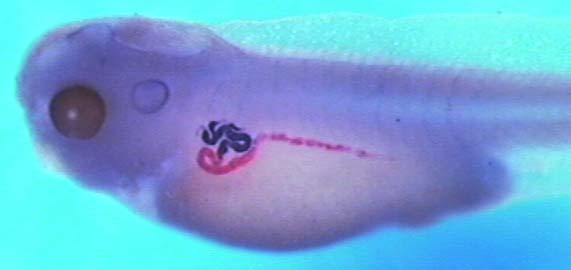3G8- pronephros and otic vesicle: Difference between revisions
(Created page with "'''Antigen:''' dissected pro nephroi, specific target unknown '''Epitope:''' '''Host Species/Isotype:''' mouse monoclonal IgG '''Antigen Species:''' '''...") |
No edit summary |
||
| (7 intermediate revisions by 4 users not shown) | |||
| Line 1: | Line 1: | ||
'''Antigen:''' | '''Antigen:''' dissected pronephroi, specific target unknown | ||
'''Epitope:''' | '''Xenbase Gene Page:''' | ||
'''Host Species/Isotype:''' | '''Epitope:''' Unknown- but localized to apical surface/brush border. | ||
'''Antigen Species:''' | '''Host Species/Isotype:''' mouse monoclonal IgG | ||
'''Applications:''' | '''Antigen Species:''' Xenopus laevis | ||
'''Antibody Name:''' | '''Applications:''' Immunofluorescence, immunohistochemistry | ||
'''Supplier:''' | '''Antibody Name/Catalog Number:''' 3G8 | ||
'''Comments:''' | '''Supplier:''' EXRC [http://www.port.ac.uk/research/exrc/antibodies/Antibodies/] | ||
'''Comments:''' IP unknown, does not work on Westerns | |||
[[File:3G8.jpg]] | |||
Note- the blue stain in this image is by antibody 3G8, the red stain is by antibody 4A6 [http://www.xenbase.org/xenwiki/index.php/Monoclonal_4A6_-_pronephros] | |||
'''Contributor:''' Generated and characterized by Elizabeth Jones [http://www.xenbase.org:80/community/person.do?method=display&personId=753]. References: Dev Bio 171:531- [http://www.xenbase.org/literature/article.do?method=display&articleId=19219] | |||
'''Additional Information:''' '''Developmental Window:''' First detects target at stage 31, continues until latest stages tested. As this antibody stained only the lumen of the pronephric proximal tubules the shape of the organ looks odd in early stages and only begins to look like a pronephros at around stage 34 when a well luminized epithelial tubule network has formed. | |||
'''Stains:''' proximal pronephric nephron, nephrostomes and otic vesicle, | |||
'''Fixatives:''' formalin, MEMFA, TCA are all OK. Following fixation sample must be dehydrated with methanol for the antibody to work optimally. Others not tested. The target degrades over time in alcohol, so samples should be stored for less than one month post-fixation. | |||
'''Sensitive to bleaching:''' No, though store time in methanol may be shortened by bleaching | |||
''' | |||
'''Functions post in situ?:''' No | |||
'''Optimized conditions:''' Very clean antibody, very stable, can be reused. Development in BCIP/NBT usually takes 30 minutes, in red, about 60 minutes. Works well in immunofluorescense. As the pronephros is only covered by a thin transparent epidermis it is not necessary to clear stained embryos. In cleared embryos both pronephroi are often in view, one in focus and one blurred, and this can make photography difficult see for example stage 32 sample above. | |||
'''Other species:''' works on other anurans (Bombina), and also on axolotls when formalin plus 10% DMSO is used as the fixative, but it isn't nearly as clean as with Xenopus or Bombina. This is probably just a protocol problem. Reported to work on zebrafish. | |||
'''Functions post in situ?:''' No | '''XAO:''' | ||
'''Optimized conditions:''' Very clean antibody, very stable, can be reused. Development in BCIP/NBT usually takes 30 minutes, in red, about 60 minutes. Works well in immunofluorescense. As the pronephros is only covered by a thin transparent epidermis it is not necessary to clear stained embryos. In cleared embryos both pronephroi are often in view, one in focus and one blurred, and this can make photography difficult see for example stage 32 sample above. | '''Reference(s):''' Dev Bio 171:531- [http://www.xenbase.org/literature/article.do?method=display&articleId=19219] | ||
'''Other species:''' works on other anurans (Bombina), and also on axolotls when formalin plus 10% DMSO is used as the fixative, but it isn't nearly as clean as with Xenopus or Bombina. This is probably just a protocol problem. Reported to work on zebrafish. | applications abbreviations: | ||
'''XAO:''' | WB - Western blotting, | ||
IP - immunoprecipitation, | |||
IF - immunofluorescence, | |||
IHC - immunohistochemistry, | |||
EMSA - electromobility shift assay, | |||
ChIP - chromatin immunoprecipitation, | |||
FCM - flow cytometry | |||
Latest revision as of 14:24, 28 September 2011
Antigen: dissected pronephroi, specific target unknown
Xenbase Gene Page:
Epitope: Unknown- but localized to apical surface/brush border.
Host Species/Isotype: mouse monoclonal IgG
Antigen Species: Xenopus laevis
Applications: Immunofluorescence, immunohistochemistry
Antibody Name/Catalog Number: 3G8
Supplier: EXRC [1]
Comments: IP unknown, does not work on Westerns
 Note- the blue stain in this image is by antibody 3G8, the red stain is by antibody 4A6 [2]
Note- the blue stain in this image is by antibody 3G8, the red stain is by antibody 4A6 [2]
Contributor: Generated and characterized by Elizabeth Jones [3]. References: Dev Bio 171:531- [4]
Additional Information: Developmental Window: First detects target at stage 31, continues until latest stages tested. As this antibody stained only the lumen of the pronephric proximal tubules the shape of the organ looks odd in early stages and only begins to look like a pronephros at around stage 34 when a well luminized epithelial tubule network has formed.
Stains: proximal pronephric nephron, nephrostomes and otic vesicle,
Fixatives: formalin, MEMFA, TCA are all OK. Following fixation sample must be dehydrated with methanol for the antibody to work optimally. Others not tested. The target degrades over time in alcohol, so samples should be stored for less than one month post-fixation.
Sensitive to bleaching: No, though store time in methanol may be shortened by bleaching
Functions post in situ?: No
Optimized conditions: Very clean antibody, very stable, can be reused. Development in BCIP/NBT usually takes 30 minutes, in red, about 60 minutes. Works well in immunofluorescense. As the pronephros is only covered by a thin transparent epidermis it is not necessary to clear stained embryos. In cleared embryos both pronephroi are often in view, one in focus and one blurred, and this can make photography difficult see for example stage 32 sample above.
Other species: works on other anurans (Bombina), and also on axolotls when formalin plus 10% DMSO is used as the fixative, but it isn't nearly as clean as with Xenopus or Bombina. This is probably just a protocol problem. Reported to work on zebrafish.
XAO:
Reference(s): Dev Bio 171:531- [5]
applications abbreviations:
WB - Western blotting,
IP - immunoprecipitation,
IF - immunofluorescence,
IHC - immunohistochemistry,
EMSA - electromobility shift assay,
ChIP - chromatin immunoprecipitation,
FCM - flow cytometry